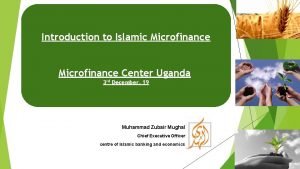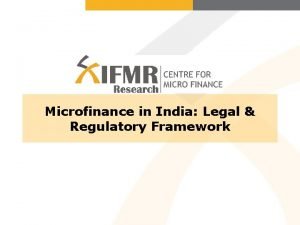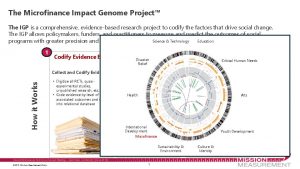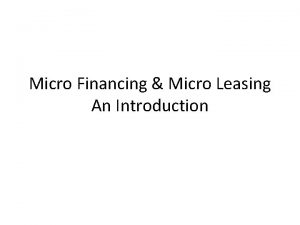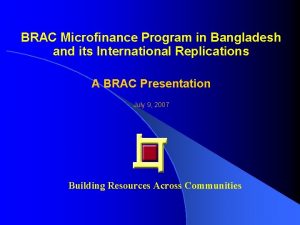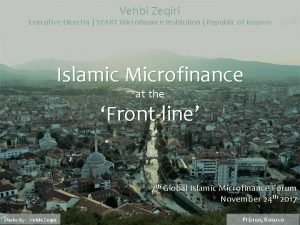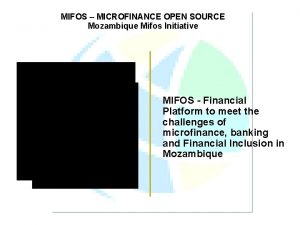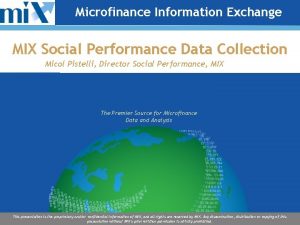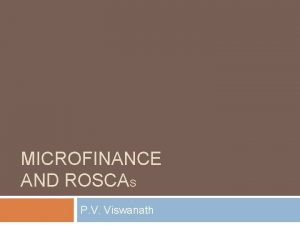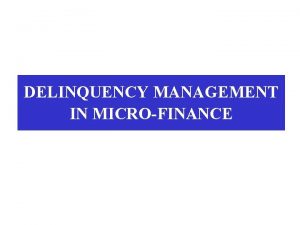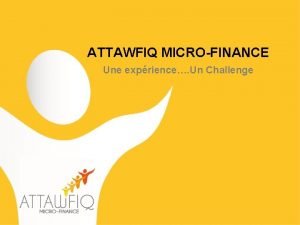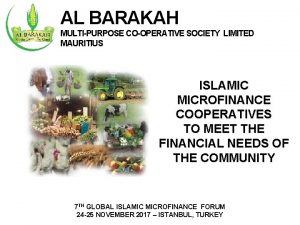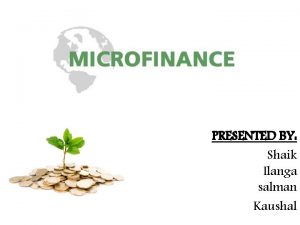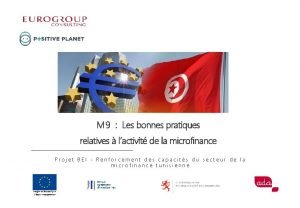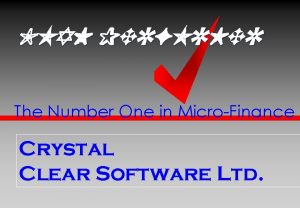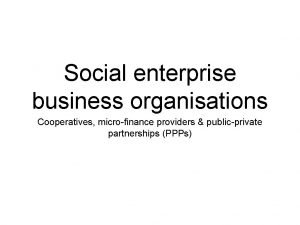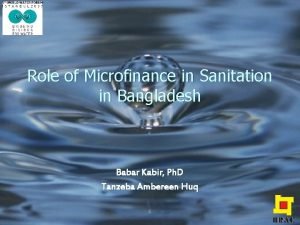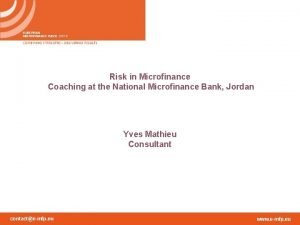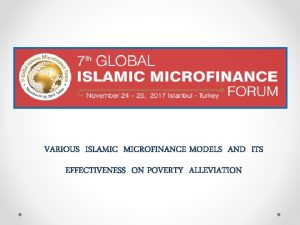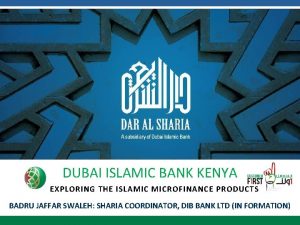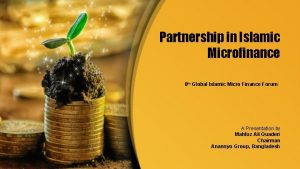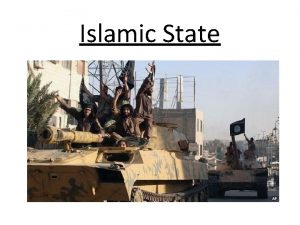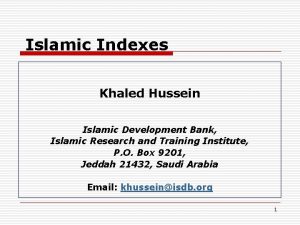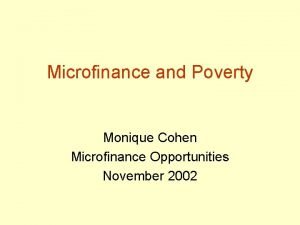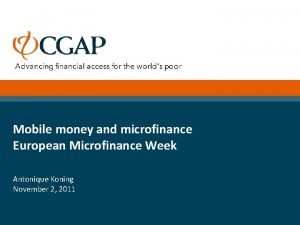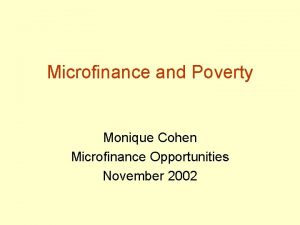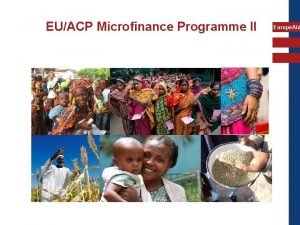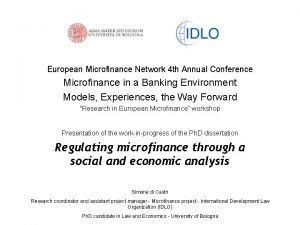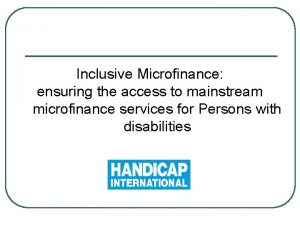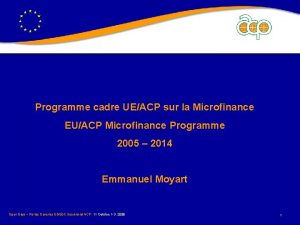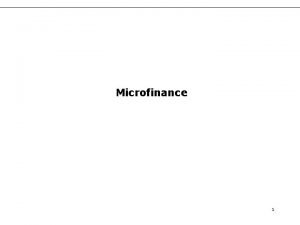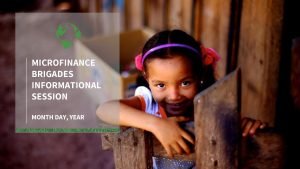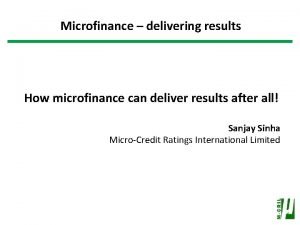VARIOUS ISLAMIC MICROFINANCE MODELS AND ITS EFFECTIVENESS ON



















- Slides: 19

VARIOUS ISLAMIC MICROFINANCE MODELS AND ITS EFFECTIVENESS ON POVERTY ALLEVIATION Moinuddin Ul Islam Ali Mohamed Baharoon MSc In Islamic Banking and Finance IIUM Institute of Islamic Banking and Finance

INTRODUCTION Microfinance is, “A program that offers small amount of loans to poor people for selfemployment projects that generate income in allowing them to take care of themselves and their families. ” Started in Bangladesh in 1976 responding to the wide spread famine in 1974. Islamic microfinance is, “ Confluence of two rapidly growing industries: Microfinance and Islamic finance” - Consultative Group to Assist the Poor (CGAP).

GENRAL FEATURES • Difference between microfinance and finance schemes, is collateral. • Various models include: Village/rural banks: Individual loans and repaid principal plus interest on weekly or monthly intervals. Group financing : Individuals come together to form small groups and apply for financing. • There are more than 300 Islamic MFIs. • Operates similar to conventional microfinance but without interest. • Operates as a business partner with clients rather than loan shark. • Total assets of Islamic MFIs were $800 million in 2013 , they serve about 1. 3 million clients

ISLAMIC MFI MODELS AND INSTRUMENTS Marketbased model Non-profit model Instruments used Zakah Waqf Qard al Hasan Murabahah Ijarah Muntahiya Bittamlik

AKHUWAT( )ﺍﺧﻮﺕ • Akhuwat ( )ﺍﺧﻮﺕ is derived from the word “Mwakhwaat” or brotherhood and has more than 300 branches located across Pakistan since 2001. • Uses the model of Qard al Hasan (benevolent loan) to the poor and destitute. • Average loan size USD 144. • Has repayment rat of 99. 89% (company website).

TYPES OF ASISTANCE (PRODUCT)

TYPES OF ASISTANCE (PRODUCT) Education Loan Health Loan Housing Loan Emergency Loan Marriage Loan

TYPES OF ASISTANCE (PRODUCT) Family Enterprise Loan Comprises 91% of loan portfolio Entire family must get involved Amount ranges from USD 98 -USD 295 Liberation Loan Rescue people from interest-bearing loan The limit of the loan is up to USD 491.

LENDING METHODOLOGY Eligibility Criteria • No discrimination on the basis of cast, gender or religion. • Person should be below poverty line. • Should have a reliable social capital. • Should not be involved in any illegal activities. Process of Lending • Akhuwat financing pivots around mosque based arrangement. • Checks the eligibility criteria of the people applied for loan. • Uses collateral-free group and individual financing based on mutual guarantees. The borrower’s family members are requested to get involved with the loan process and two guarantors are asked to present. • Money is distributed with an administration fee of 5%.

RISK MANAGEMENT • Utilization of religion and culture as risk management tool. • Once the loan has been disbursed, the Unit Manager monitors the client with regular. visits to his residence and place of work. • Having two guarantors for each client

RURAL DEVELOPMENT SCHEME

RURAL DEVELOPMENT SCHEME (RDS) • Bangladesh has a population of 154. 7 million out of which 26% live below poverty line - (World Bank statistics, 2012) • Issue of “interest” discourages people to approach Grameen Bank. • RDS was introduced in 1995 by Bangladesh’s first private Islamic bank called Islamic Bank Bangladesh Ltd. to cater to the investment needs of the agriculture and rural sector. • It is treated as first Islamic Microfinance Model in the country

LENDING METHODOLOGY Eligibility Criteria Process of Lending • Bank selects villages within a 10 km radius of the branch premises and look for area which includes easy communication, availability of agriculture and abundance of low-income people. • Able bodied rural poor people having age between 18 to 50 years. • Farmers having cultivable land maximum 0. 50 acres. • Persons engaged in very small off-farm activities in the rural areas. • Destitute women. • Identification of economic activities in the area is carried out after eligibility criteria is fulfilled. • RDS practices Murabahah modes of investment for financing the clients. • RDS purchase goods and sell them to the clients adding only 12. 5 % profit on flat rate with a rebate of 2. 5 % for timely payment.

RISK MANAGEMENT Mudarabah deposit • Each member of the Group has to deposit minimum BDT 20 (USD 0. 25) only per week as Centre Fund. This Fund is kept by opening a Mudarabah Savings Account in the name of the respective center. • Two members from each group are selected by the group members will be considered for investment financing. • The rest of the group members become eligible for financing after those members of the group that received a loan have paid their 2 or 3 repayment installments.

ISSUES AKHUWAT • Encouragement to continued dependency on charity • Inadequate risk management strategy. • Poor accountability and governance structures. • Lack of segregation of different types of funds such as Zakah and Sadaqah. RDS • Overwhelming concentration of murabaha • Less emphasis on project viability • High cost of finance • Perpetuation of debt

PROBABLE ALTERNATIVE CASH WAQF - Investment return from Cash Waqf can be used to cover the operational cost. - Should create buffer zone to counter financial shocks in managing risk. - The remaining is invested as Source of Capital for Microfinancing purposes.

PROBABLE ALTERNATIVE Micro. Entrepreneurs (Musharakah) Micro-traders (Mudarabah) Small land owners (Salam) Poor with capacity work (Qard Hassan) Destitute / Unable to work (Sadaqah)

CONCLUSION • Both the models have made strong marks in respective countries • The models have issues which can be fixed for the expansion and sustainability of the industry. • More concentration should be given on equity-based products than debt-based to reduce cost and maximize benefit. • Islamic microfinance institutions should not be aggressive in making profit as they are dealing with the poor and needy. • More non-bank Islamic finance institutions should join the Islamic microfinance market as they will be able to tap areas which the banking institutions are failing • Ultimately, Islamic MFIs need to come out of this vicious cycle of perpetual poverty created by conventional microfinance and come closer to the main objective of microfinance i. e. alleviation of poverty.

 Islamic microfinance in uganda
Islamic microfinance in uganda Legal and regulatory framework of microfinance in india
Legal and regulatory framework of microfinance in india Difference between model and semi modals
Difference between model and semi modals Expand igp in microfinance
Expand igp in microfinance Microfinance meaning
Microfinance meaning Bep mis.brac.net
Bep mis.brac.net Vehbi ko
Vehbi ko Open source microfinance banking software
Open source microfinance banking software Microfinance information exchange
Microfinance information exchange Rosca model of microfinance is
Rosca model of microfinance is Good shepherd micro finance
Good shepherd micro finance Delinquency management in microfinance
Delinquency management in microfinance Attawfiq microfinance
Attawfiq microfinance Al barakah
Al barakah Characteristics of microfinance
Characteristics of microfinance Définition de la microfinance
Définition de la microfinance Loan performer software free download
Loan performer software free download Microfinance
Microfinance Microfinance
Microfinance National microfinance bank jordan
National microfinance bank jordan
